Judi Lynn
Judi Lynn's JournalWhy Cuban cigars are so expensive
Andy Ash Jul 12, 2020, 5:00 AM
- see video at link -
Below is a transcript of the video:
Narrator: Cuban cigars hold a reputation as the world's most opulent tobacco product. A box of good-quality Habanos can cost thousands of dollars. Every hand-rolled Cuban cigar goes through about 500 manual tasks from seed to cigar. But over the last 25 years, cigars made in other countries in the Caribbean and Central America have become comparable in quality, consistency, and cost. Worse still for American smokers, your Cuban cigar could be fake. Some experts suggest that up to 95% of all Cuban cigars in the US are actually counterfeit. So why are Cuban cigars so desirable? And is that why they're so expensive? For more than 200 years, the culture of cigar making in Cuba hasn't changed. In a process that takes about a year, tobacco leaves are grown, harvested, and hung in drying houses called secaderos before a slow fermentation occurs, which enhances flavor, aroma, and burning characteristics. Each leaf is inspected for its type, appearance, and quality and handed to a torcedor, a highly skilled cigar roller, greatly respected in Cuban society.
José Castelar Cairo: "My name is José Castelar Cairo. I work here in La Triada. I have been a cigar maker for 61 years. To make cigars here in Cuba, we depend on five types of leaves: a leaf that is called ligero, which is the one that gives strength in the cigar; another leaf that is called seco, the one with the aroma; another leaf is called volado, which is in charge of the combustion inside the cigar. It is followed by the binder that wraps the ligero, seco, and volado. And the last leaf is the wrapper, which is what I am doing, is the one that dresses the cigar, and the wrapper gives presence to the cigar."
Narrator: The heartland of Cuban cigar production is in Pinar del Río, the westernmost province of the island, where 70% of premium cigar tobacco used by state-run cigar companies is grown. Cuban tobacco growers claim that the fundamental influence on quality is the region's terroir, the unique environmental factors that affect a crop.
Richey Morin Rico: "The first thing to be considered as the best cigar in the world is that four factors make it unique. It is the soil where it is grown, the climate of the region where it is grown, the manual labor, and the variety of black tobacco used. I know that they have tried to take the strain many times, have tried to take the seed, and have tried to take the workmanship. Still, in all the places where they have put it with similar conditions, it has not been achieved in the same way."
More:
https://www.businessinsider.com/why-are-cuban-cigars-so-expensive-2020-7
~ ~ ~
It was charming learning about this habit which has evolved in Cuba in the places which make cigars. I had to go find an article on the readers to add to this article:
Page last updated at 17:57 GMT, Thursday, 10 December 2009
Reading while rolling Cuba's famous cigars
How cigars are produced in Cuba
Despite a slump in sales due to the recession, Cuba continues to be the world's largest producer of cigars. Could its success be due to cigar factory readers? BBC correspondent in Havana, Michael Voss, finds out.
The air in H Upmann's cigar factory in Havana's Vedado district is thick with the sweet pungent smell of tobacco.
It's hot and humid. There is no air conditioning because that would dry out the precious leaves.
In the long main galley, row upon row of workers sit side by side on long wooden benches - dozens of men and women all rolling cigar after cigar.
Producing Cuba's famous handmade cigars is a highly skilled but monotonous job which demands concentration.
There's no time for chatting to workmates - quotas must be met.
At the front of the room there's a raised platform where a lone figure sits in front of a microphone, reading out loud the official state newspaper Granma.
Instead of canned music, many cigar factories in Cuba still rely on the ancient tradition of employing a reader to help workers pass away the day.
Gricel Valdes-Lombillo, a matronly former school teacher, has been this factory's official reader for the past 20 years.
In the morning she goes through the state-run newspaper Granma cover to cover.
Later in the day she returns to the platform to read a book.
More:
http://news.bbc.co.uk/2/hi/8406641.stm
![]()
![]()
![]()
Photos of readers, from google images:


https://images2.minutemediacdn.com/image/upload/c_fill,g_auto,h_1248,w_2220/f_auto,q_auto,w_1100/v1555375852/shape/mentalfloss/pretexts.jpg





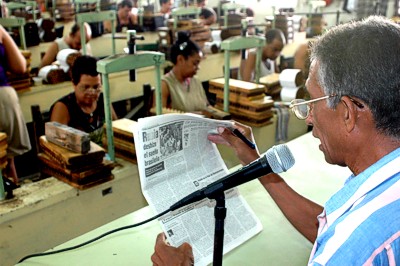

Hummingbirds Learn to Count to Find Their Favorite Flowers
Researchers found that wild rufous hummingbirds could remember which flower in a sequence held nectar

A Rufous Hummingbird sips on the nectar from an Orange Justicia plant in California (Mark Boster / Los Angeles Times via Getty Image)
By Theresa Machemer
SMITHSONIANMAG.COM
JULY 10, 2020
New research suggests that wild hummingbirds can keep count as they forage and use their counts to keep track of the sweetest flowers.
The new paper, published on July 8 in the Proceedings of the Royal Society B, found that male rufous hummingbirds can learn which fake flower in a sequence holds a nectar-like syrup. Only one flower in ten held syrup. But even when the researchers moved the location of the artificial flowers and the distances between them, scientists observed the birds returning to the syrup-filled flower.
“They would never lose their car in the car park,” says biologist Susan Healy of the University of St. Andrews to Cathleen O’Grady at Science magazine.
Hummingbirds join a growing club of animals that can understand sequences, which includes rats, guppies and monkeys. Last year, researchers showed that Emory University showed that dogs use a brain region for number processing that’s analogous to the region used by humans, Katherine Wu wrote for Smithsonian last December.
The new research is unique because it focuses on counting ability in the wild, rather than in a lab.
More:
https://www.smithsonianmag.com/smart-news/hummingbirds-learn-count-find-their-favorite-flowers-180975285/

Che Guevara's birth home is up for sale in Argentina
By Kelly Murray, CNN
Updated 1746 GMT (0146 HKT) July 12, 2020
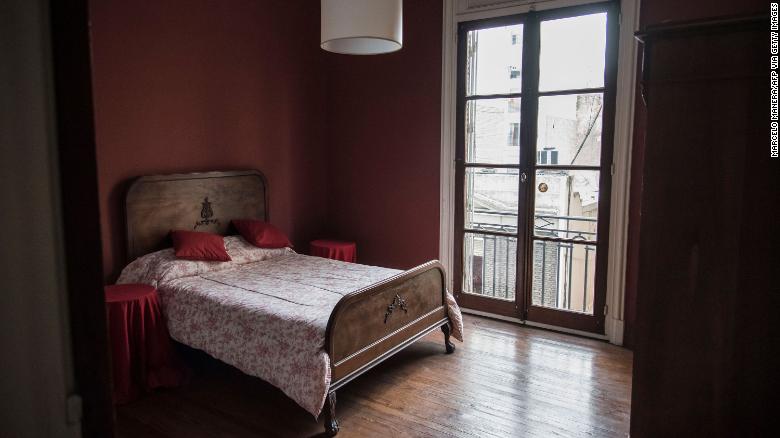
View of a bedroom in the apartment where Argentinian revolutionary legend Ernesto "Che" Guevara was born in Rosario, Argentina.
(CNN)For around $400,000, you can own the home where controversial Marxist revolutionary Ernesto "Che" Guevara was born, according to official Argentine news agency, Télam.

View of a bedroom in the apartment where Argentinian revolutionary legend Ernesto "Che" Guevara was born in Rosario, Argentina.
Situated 186 miles north of Buenos Aires in the city of Rosario, Argentina, the 2,150-square-foot apartment has been uninhabited since 2011, according to Agencia Télam.
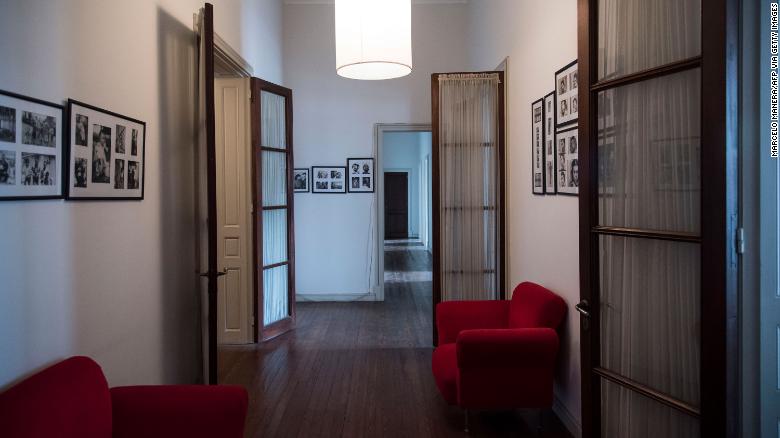
Photos of Ernesto "Che" Guevara hang in the apartment he was born.
More:
https://edition.cnn.com/2020/07/12/americas/ernesto-che-guevara-birth-home-sale-argentina-trnd/index.html
~ ~ ~

Celia de la Serna y Llosa with her baby son Ernesto Guevara de la Serna, in late 1928. Picture: AFP

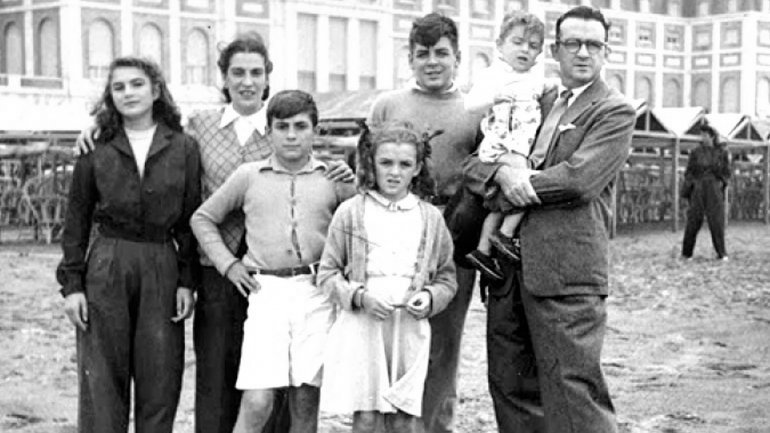
Family of architect Ernesto Guevara Lynch (1900 - 1987) and Celia De La Serna.

Guevara with his second wife, Aleida March, on their wedding day in
Havana, on June 2, 1959. Picture: AFP

Raul Castro (right) with Guevara in Havana. Picture: AFP
Guevara wears Cuban revolutionary Commander Camilo Cienfuegos' hat after he exchanged it for his beret during a rally in Havana in 1959. Picture: AFP



Camille Cienfuegos, wearing his
own damned hat!

What Chocolate-Drinking Jars Tell Indigenous Potters Now
July 7th, 2020, 11:49AM / BY Abigail Eisenstadt
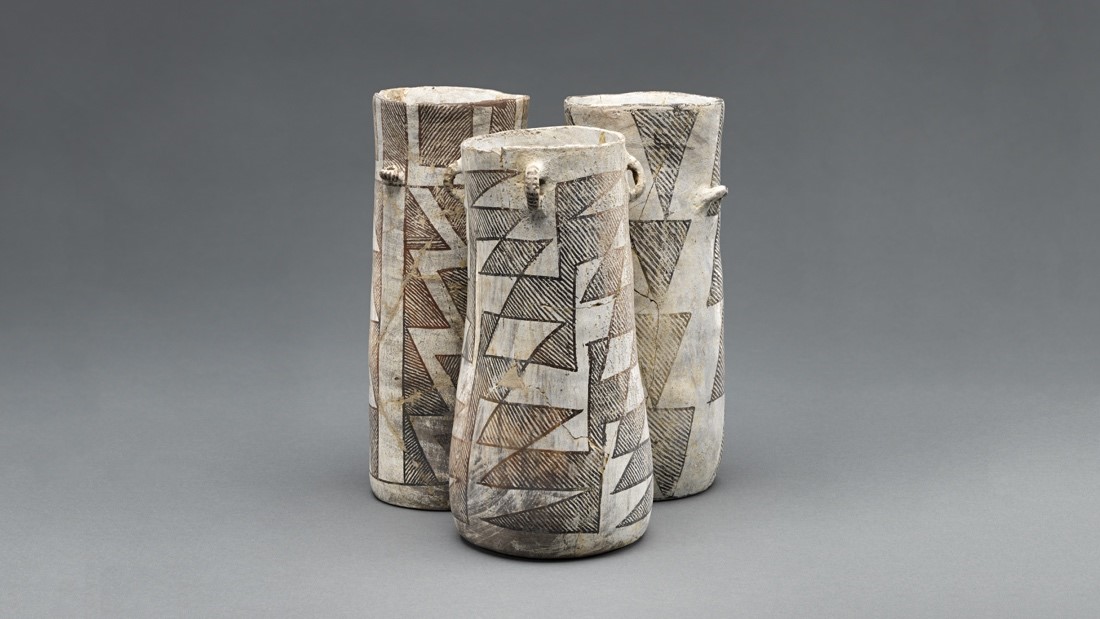
The Chaco Canyon chocolate-drinking jars have a distinct shape, with connections to similarly shaped Mayan vessels. After testing distinguishable jar fragments from an excavated trash pile in in the canyon, archaeologists determined all of the drinking jars were used to consume cacao. (A336494, A336499, A336493, James Di Loreto, Smithsonian)
When an archaeologist found traces of cacao residue in Puebloan cylinder drinking jars a decade ago, the implications were huge. Her discovery of chocolate proved that Southwestern desert dwellers in Chaco Canyon had been trading with tropical Mesoamerican cacao-harvesters, like the Maya, as far back as 900 CE.
But the drinking vessels are as significant as the chocolate hidden inside them. They are living proof of a dynamic pottery-making tradition that continues in descendant tribes of the Chaco Canyon Puebloans today.
In the early 1900s, the Smithsonian’s National Museum of Natural History joined an archaeological expedition that collected some of the cylinder vessels from Chaco Canyon. Two of them are now on display at the museum’s “Objects of Wonder” exhibit. The jars’ acquisition is a reminder of the museum’s colonial past, but nowadays the museum’s anthropologists have a new purpose for the jars and other pottery: to connect them with indigenous people who are spearheading cultural revitalization in their communities.
For example, the museum’s Recovering Voices program works with indigenous communities like the Hopi descendants of the Chaco Puebloans to better understand pottery-making traditions. It also brings established potters to the collection so that they can study it for the next generation.
More:
https://www.smithsonianmag.com/blogs/national-museum-of-natural-history/2020/07/07/what-chocolate-drinking-jars-tell-indigenous-potters-now/
Prez Esquivel raises his voice for the Nobel Prize to Cuban doctors

Buenos Aires, July 12 (Prensa Latina) Argentinean Nobel Peace Prize winner, Adolfo Pérez Esquivel, is promoting today, together with many of his countrymen and women, the international demand to grant the Nobel Peace Prize to the Cuban medical brigade Henry Reeve. In a video circulated by the Argentine Movement of Solidarity with Cuba (MasCuba), the prominent human rights defender expressed his support for the candidacy of the Cuban doctors that are today around the world saving lives in the midst of the pandemic.
Cuban health professionals, he said, deserve the Nobel for all the humanitarian work they do in the most inhospitable and needy places. In the face of this global pandemic, they are present to serve the human being; they are the builders of peace, Perez Esquivel stressed. In Argentina, more than 500 signatures and adhesions from some 80 organizations gathered through an active Broad Commission support the demand that the Cuban medical brigade Henry Reeve be granted the Nobel Peace Prize.
At the moment, over 2,500 of them, grouped in 37 brigades, are risking their lives in Italy, Jamaica, Belize, Mexico, Venezuela, Antigua and Barbuda, Andorra, Togo, Peru, South Africa, Kuwait, among other countries, and ready to come to Argentina if the national government makes its request for help concrete, the petition points out.
https://www.plenglish.com/index.php?o=rn&id=57692&SEO=perez-esquivel-raises-his-voice-for-the-nobel-prize-to-cuban-doctors
(Short article, no more at link.)
NYT Acknowledges Coup in Bolivia--While Shirking Blame for Its Supporting Role
JULY 8, 2020
CAMILA ESCALANTE
NYT Acknowledges Coup in Bolivia—While Shirking Blame for Its Supporting Role

The New York Times (6/7/20) declared that an Organization of American States (OAS) report alleging fraud in the 2019 Bolivian presidential elections—which was used as justification for a bloody, authoritarian coup d’etat in November 2019—was fundamentally flawed.
The Times reported the findings of a new study by independent researchers; the Times brags of contributing to it by sharing data it “obtained from Bolivian electoral authorities,” though this data has been publicly available since before the 2019 coup.
The article never uses the word “coup”—it says that President Evo Morales was “push[ed]…from power with military support”—but it does acknowledge that “seven months after Mr. Morales’s downfall, Bolivia has no elected government and no official election date”:
A staunchly right-wing caretaker government, led by Jeanine Añez…has not yet fulfilled its mandate to oversee swift new elections. The new government has persecuted the former president’s supporters, stifled dissent and worked to cement its hold on power.
“Thank God for the New York Times for letting us know,” must think at least some casual readers, who trust the paper’s regular criticism of rising authoritarianism within the US—perhaps adding, “Well, I guess it’s too late to do anything about Bolivia now.”
More:
https://fair.org/home/nyt-acknowledges-coup-in-bolivia-while-shirking-blame-for-its-supporting-role/
Nigeria: 11-year old dancer challenges ballet stereotypes
A recent video of 11-year-old Anthony Mmesoma Madu dancing in the rain went viral with the likes of Hollywood superstar Viola Davis and other celebrities sharing the video.
Anthony is one of the 12 students at the Leap of Dance Academy in Lagos.
The academy, founded in 2015, is the brainchild of Daniel Ajala Owoseni who has been been teaching ballet for free without a dance space.
- video at link -
https://www.bbc.com/news/av/world-africa-53346840/nigeria-11-year-old-dancer-challenges-ballet-stereotypes
How Cuba and Uruguay are quashing coronavirus as neighbours struggle
HEALTH 3 July 2020
By Luke Taylor

Nurse Yosian Diago checks door-to-door for people with symptoms of covid-19 in Havana, Cuba, in June
Alexandre Meneghini/Reuters/PA Images
As coronavirus cases soar in the US, Brazil and other countries in the Americas, some countries have found strategies to contain the virus and limit deaths.
More than 5 million confirmed cases of covid-19 and nearly 250,000 related deaths have been reported in the Americas as of 29 June, around half of the world total. The coronavirus is spreading exponentially in many countries, warned Carissa Etienne, the director of the Pan American Health Organization (PAHO) on 9 June.
But in a few places, the picture is very different. Cuba, an island of 11.3 million people is an unlikely exemplar of how to manage a pandemic, according to Michael Bustamante at Florida International University. Its infamously long queues for state-provided goods make social distancing and self-isolation difficult, he says, and the country’s healthcare system, “suffers from scarcities and material shortages that are characteristic of the Cuban economy as a whole”.
. . .
What the health system lacks in materials, it makes up for in workforce – it has the highest doctor-per-patient ratio in the world, 8.19 per 1000. By comparison, Brazil has 2.15, and the US 2.6.
Read more: https://www.newscientist.com/article/2247740-how-cuba-and-uruguay-are-quashing-coronavirus-as-neighbours-struggle/#ixzz6Rb9jJpWk
During Mercosur Summit Argentina's Fernandez Ratifies his Rejection of the De Facto Regime in Bolivi
July 4, 2020
In the framework of the virtual summit of Mercosur, the President of Argentina, Alberto Fernández, made evident his distancing from and disagreement with the de facto government of Bolivia, chaired by Jeanine Añez, with the simple and notorious gesture of abandoning the videoconference in the just moment when Añez spoke, irrefutable proof that there is an important gap in the relations of both governments and a fracture within Mercosur.
“The TV coverage in Argentina was turned off just after Uruguay’s Luis Lacalle Pou finished speaking and the provisional president of Bolivia, Jeanine Añez, was just beginning to speak,” says the right wing Clarín website.
In the same way, the conservative outlet describes the action as “a disrespect” by President Fernández, adding that the leader “rose from the plenary session because he considered Bolivia to be a de facto government”, that is, a government that was implanted after force, violence, death and not by democratic and electoral means, as the people and the constitution mandates.
https://twitter.com/OrinocoTribune/status/1279187834826633217?ref_src=twsrc%5Etfw%7Ctwcamp%5Etweetembed%7Ctwterm%5E1279187834826633217%7Ctwgr%5E&ref_url=https%3A%2F%2Forinocotribune.com%2Fduring-mercosur-summit-argentinas-fernandez-ratifies-his-rejection-of-the-de-facto-regime-in-bolivia%2F
More:
https://orinocotribune.com/during-mercosur-summit-argentinas-fernandez-ratifies-his-rejection-of-the-de-facto-regime-in-bolivia/?fbclid=IwAR3sUHyF-ya6LU6I9cWlwa7hq0DUPpSc8JKSLs0txn7845wUsQaZc7QxTz4
The Indigenous Peruvian Trap Music of Renata Flores
posted by Jason Kottke Jul 07, 2020
Quechua is an indigenous language family spoken by millions of people in the Andean region of South America, primarily in Peru, Ecuador, and Bolivia. It was the main language of the Inca empire and today is the most widely spoken pre-Columbian language in the Americas. In her music, Peruvian singer/songwriter Renata Flores combines modern forms like hip hop, electronic, and trap music with native instruments and vocals sung in Quechua. Here’s the video for one of her most popular songs, Tijeras:
Flores also does covers of pop songs (Billie Eilish’s Bad Guy, Fallin’ by Alicia Keys) and
she first captured people’s online attention with a Quechua cover of Michael Jackson’s
The Way You Make Me Feel performed when she was 14 years old:
Rosa Chávez Yacila wrote an article for Vice about Flores and her music last year.
Her use of Quechua in pop music brought the language out of private spaces into the
public.
More:
https://kottke.org/20/07/the-indigenous-peruvian-trap-music-of-renata-flores
(No one should be able to obscure the real reason: the descendants of the original invaders, slavers, genocidal power-mad racist Europeans have ALWAYS hated, and violently abused the remaining indigenous people of the Americas, from the Artic to the southernmost tip of Chile. They have ALL taken abuse, and have lived being treated as trash every day of their lives. In Bolivia, the Inca indigenous people are often referred to as "fu##ing Indians", "llama abortions" and anything else they have handy.
THAT'S why they have felt inferior, and despised all this time.
Long past time the racists got it all stacked back on them, forever. They are vicious idiots.
Renata is courageous.
Profile Information
Member since: 2002Number of posts: 160,511
